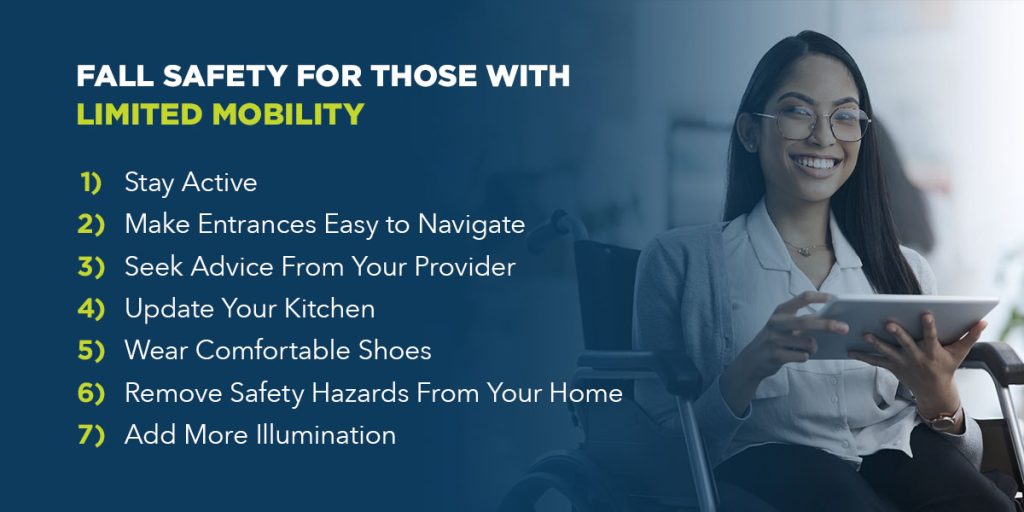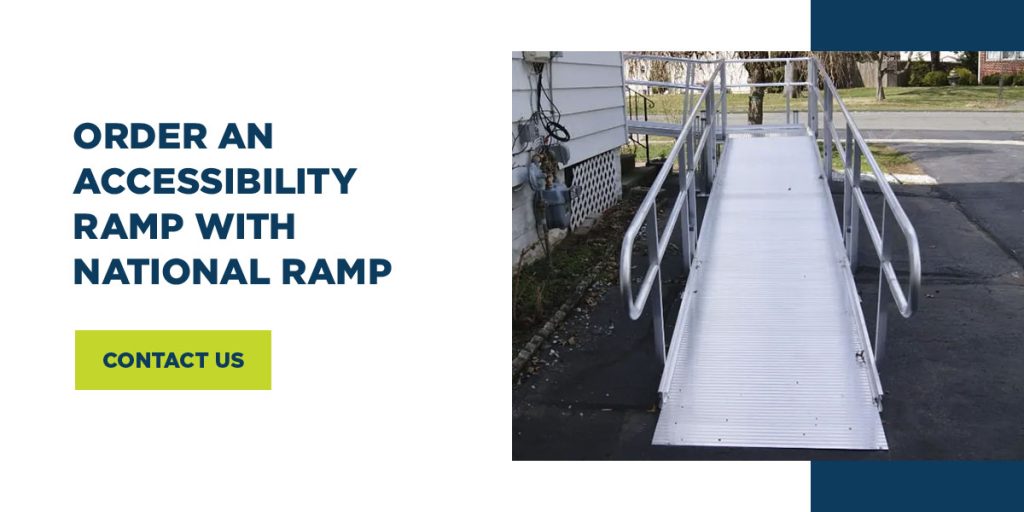
If you or a member of your household has limited mobility, it’s important to be aware of fall prevention strategies at home you can rely on to limit risks. Below are seven tips for improving your home’s accessibility and safety. Keep reading to learn how to prevent falls in elderly family members or people with mobility challenges.
In This Article
- Stay Active
- Make Entrances Easy to Navigate
- Seek Health Care Advice From Your Provider
- Update Your Kitchen
- Wear Comfortable Shoes
- Remove Safety Hazards From Your Home
- Add More Illumination
- Order an Accessibility Ramp With National Ramp

1. Stay Active
If it’s your first time using a mobility device or you have recently experienced a mobility limitation, it’s important to stay active to keep your muscles strong. If your health care provider approves, consider keeping your level of physical activity up.
Light activities like walking or yoga can help improve your balance, coordination and strength. Staying active can also help with your mental health. You might feel like you should avoid physical activity because it could put you at a greater risk of suffering a fall, but your doctor may determine the benefits of maintaining a healthy activity level outweigh any risk. Work together to create a monitored exercise plan at home or with a physical therapist.
Working with a physical therapist to stay active is a good choice if your mobility is extremely limited. A custom exercise program can be very beneficial, even if you’ve moved beyond the improvement stage and into the maintenance phase of your mobility journey.
2. Make Entrances Easy to Navigate
Entrances are one of the most important areas of your home for wheelchair fall prevention. They present safety hazards when entering or exiting, especially when precipitation is present. When using a wheelchair or assisting a friend up a set of stairs, even a couple of steps can pose an obstacle.
You can make your home easier to get around if you keep the floors clear of objects and use mats to ensure a wheelchair has enough traction to move smoothly through the house’s entrances. If your residence has steps, make sure you also have a ramp with a handrail on both sides. If your home has a low step, installing a grab bar can help you over it. For the best prevention possible, consider installing a ramp or using a temporary access ramp.
3. Seek Health Care Advice From Your Provider
If you or a loved one is at risk for falling, consult a doctor to discuss your specific risks and how to implement fall prevention techniques at home. Bring your list of medications to your doctor’s visit so your provider can consider any side effects or potential drug interactions that might increase your fall risk. If your doctor determines certain medications pose a serious risk, you can get an updated prescription or take steps to wean yourself off of the medication.
Mention any previous falls to your doctor. Keep a record of dates for any incidents, and record how you fell and where the fall occurred. You should also mention moments when you almost fell but caught yourself or had a caretaker lower you safely to the ground.
4. Update Your Kitchen
Your kitchen has many potential obstacles and safety hazards for elderly family members, but you can make it safer with a few adjustments. Try to minimize the amount of bending and lifting required around your kitchen with these tips:
- Reorganize your pots and pans: Hanging pans pose a safety risk and can be hard to reach for many. Place your pans on a countertop rack instead so you can also avoid having to open drawers.
- Use less storage: If you store items all over the kitchen, you have to move around more to find things. Try to confine most of your items — like the dinner plates, cups and bowls — in a single drawer that is easy to reach. Set anything you rarely use on the high shelves.
- Get a reacher: You can use this tool to retrieve items that fall on the floor so you can avoid bending over. You can also use it to reach high places or clean counters without standing on a footstool.
- Get sturdy chairs: Make sure your kitchen chairs are sturdy and arrange them in places you may need to sit down to complete house chores. If you stay in a seated position to complete tasks, you lower your risk of accidents.
- Get slide-out shelving: You can reach things more easily with shelving that slides into position. This type of shelving is especially helpful for cabinets and your refrigerator.
- Use a wheeled cart: You can move heavy things more easily across the floor with a wheeled cart for your kitchen.
- Keep your floors dry: Make sure you have a long-handled mop and dry cloths to wipe up accidental spills as they happen.
5. Wear Comfortable Shoes
If your footwear is tight or uncomfortable, it poses a risk. Avoid wearing shoes that are too big and offer little support. This is especially true for shoes like flip-flops because they can be hard to walk in when your balance is limited. If your footwear needs to be updated, consider switching shoes or buying new ones.
If you’re in the process of cleaning out your closet, consider the following:
- Replace high heels with sandals that offer good support and comfort.
- Get sole inserts for extra traction if your favorite shoes’ soles feel slick.
- Throw away any shoes with worn tread or damage to the outside.
- Shop for flat shoes that fit well to reduce and minimize joint pain.
6. Remove Safety Hazards From Your Home
Fall hazards make your residence unsafe, and most can be removed without making any renovations. Do the following to improve your home’s safety:
- Remove clutter from all walking paths, including piles of newspapers, cardboard boxes and any electrical cords.
- Rearrange coffee tables or end tables to give yourself more space to walk.
- If you have plant stands, shelf sets or magazine racks, move them into the corners of rooms and out of hallways.
- Plant nonslip mats in the bathtub and shower area, and get a bath seat so you can sit if needed.
- Remove thick rugs or use double-sided tape to hold them in place.
- Repair broken floorboards and peeling carpet.
7. Add More Illumination
Keeping your home well-lit will help you avoid trips and falls when it gets dark. Make sure your environment is easy to see at all times. You can add more illumination with:
- Night lights in your bedroom, bathroom and any hallway you have to travel through after dark.
- A bedside lamp you can switch on from a reclined position in bed.
- Illuminated light switches that glow in the dark.
- Light switches in easy-to-reach places near the tops and bottoms of staircases.
- Flashlights in various locations around your residence in case of a power outage.

Order an Accessibility Ramp With National Ramp
Do you want to install features to make your home safer and more accessible? The best fall prevention interventions come from making valuable changes to your residence. Our products can help make your home wheelchair safe. Contact us to learn more about ramp shipping and installation.
Don’t Risk Injury To You Or A Loved One
Why wait? Give us a call at 877-596-7293 or contact us online to get started!